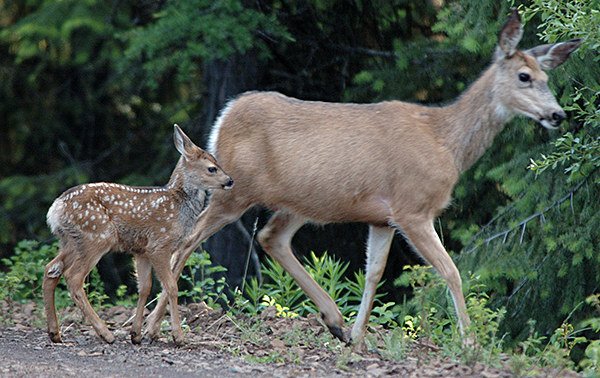It’s calf and fawn season: ODFW advises Oregonians to keep your distance from elk and deer

SALEM, Ore. (KTVZ) – Oregon's deer and elk give birth from May through July. It's natural for mother animals to leave their young alone and hidden for extended periods of time while they go off to feed, so never assume a young animal is orphaned when you see it alone. The mother will return when it's safe to do so — when people, pets or predators aren't around.
The Oregon Department of Fish and Wildlife issued a reminder this week that removing an animal from the wild is also a violation of Oregon wildlife laws. (ORS 497.308 – No person shall remove from its natural habitat or acquire and hold in captivity any live wildlife in violation of the wildlife laws.)
When people remove them from the wild, young animals miss the chance to learn where to seek cover, what to eat and how to escape from predators and other dangers. The time young animals spend with their parents and in their natural environment is crucial for the development of survival skills long term.
Fawns and calves are most vulnerable to predation in their first few weeks of life when they can't run with the herd. Their mothers will hide them in brush and go off to forage for food some distance away, sometimes for long periods so as to not call attention to their young. A fawn or calf's spotted coat helps camouflage them as they stay motionless except when nursing. They also have very little odor as another protection against attracting predators.
Fawns are sometimes mistakenly picked up by humans with good intentions, a problem that almost immediately reduces their chances of survival to zero. The doe has put half a year of intense effort into reproducing and will go to great lengths to find her fawn, often searching the area in a grid pattern. Please, leave fawns where they are.
If you encounter deer or elk, especially with young, give them space and enjoy viewing from a distance. If your presence disturbs wildlife, you're too close.
Deer and elk see dogs as a threat to their young and may act aggressively in response to disturbance from a dog. Keep pets leashed and away from wildlife. Female elk with young calves have injured and killed pets in Oregon and Washington. It is their instinct to protect their young.
Elk are large wild animals and can be aggressive without warning. Roosevelt elk are the largest elk subspecies in terms of body size, with bulls generally weighing 700-1,100 pounds. Cow elk will aggressively protect their young in the spring and summer. Bull elk become especially aggressive during the fall rut when they challenge other males and will charge anything that comes too close.